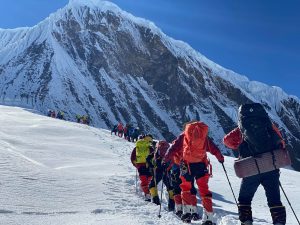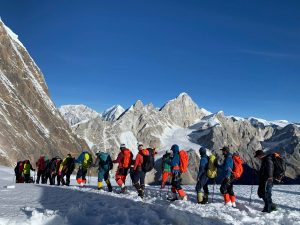Group Size
2-12
2-12
Trip Grade
Adventure
Adventure
Accommodation
Tea House / Tent
Tea House / Tent
Max. Elevation
6159 m/20201 ft
6159 m/20201 ft
Meals
B/ L / D
B/ L / D
Transportation
Flight / Private Car
Flight / Private Car
Best Season
Mar - May & Sept - Nov
Mar - May & Sept - Nov
Why Nirekha Peak Climbing
- Summit Nirekha Peak at 6,169 meters.
- Journey across the Gokyo Valley, consisting of a chain of five mountain lakes, hiking up to Gokyo Ri for breathtaking views of Everest, Cho Oyu, Pumori, Lhotse.
- Crossing Cho La Pass at 5,420 meters.
- Nirekha Peak Summit has an excellent view of the world’s largest glacier, Khumbu.
- Experience authentic Sherpa culture and tradition amid the world’s highest mountains.
Nirekha Peak Climbing is indeed an exciting and relatively less-traveled adventure located in the Khumbu region of Nepal, close to the more famous Mount Everest. It offers an opportunity for climbers to experience the thrill of summiting a mountain without the crowds typically found on more prominent peaks. Nirekha Peak stands at 6,191 meters (20,309 feet) above sea level, located in the eastern part of Nepal’s Khumbu region. It lies to the north of Namche Bazaar and is near Everest and other well-known peaks like Lhotse and Nuptse.
Highlights:
- The view from the summit of Nirekha Peak is spectacular, offering panoramic views of Mount Everest, Lhotse, Makalu, Cho Oyu, and numerous other peaks.
- The adventure offers the chance to experience the culture of the Sherpa people, visit monasteries, and trek through beautiful alpine landscapes with dense rhododendron forests and alpine meadows.

Difficulty:
- The peak is considered to be moderate in difficulty, making it suitable for climbers with prior mountaineering experience. While it is not as technically demanding as Everest or other giants, it still requires a good level of fitness, alpine skills, and preparation for altitude.

The Climb:
- The journey usually begins with a flight from Kathmandu to Lukla, followed by a trek through the Solu-Khumbu region, passing through Sherpa villages like Namche Bazaar, Thame, and Kongde.
- From here, climbers approach Nirekha Base Camp, often passing through glaciers, and icefall sections, and eventually making the ascent toward the summit.
- The climb itself involves navigating snow and ice, using crampons, ice axes, and other alpine climbing tools. Climbers will typically set up high camps before making their summit push.
Permits & Regulations:
- Climbers need to obtain peak climbing permits from the Nepal Mountaineering Association (NMA) as well as the necessary permits for trekking in the Khumbu region, such as the Sagarmatha National Park Permit.
- It is essential to go with a licensed guide or expedition leader for safety reasons, and proper acclimatization is critical due to the high altitude.
Best Time to Climb:
- The best seasons for climbing Nirekha Peak are spring (March to May) and autumn (September to November). These months offer favorable weather conditions for both trekking and climbing

